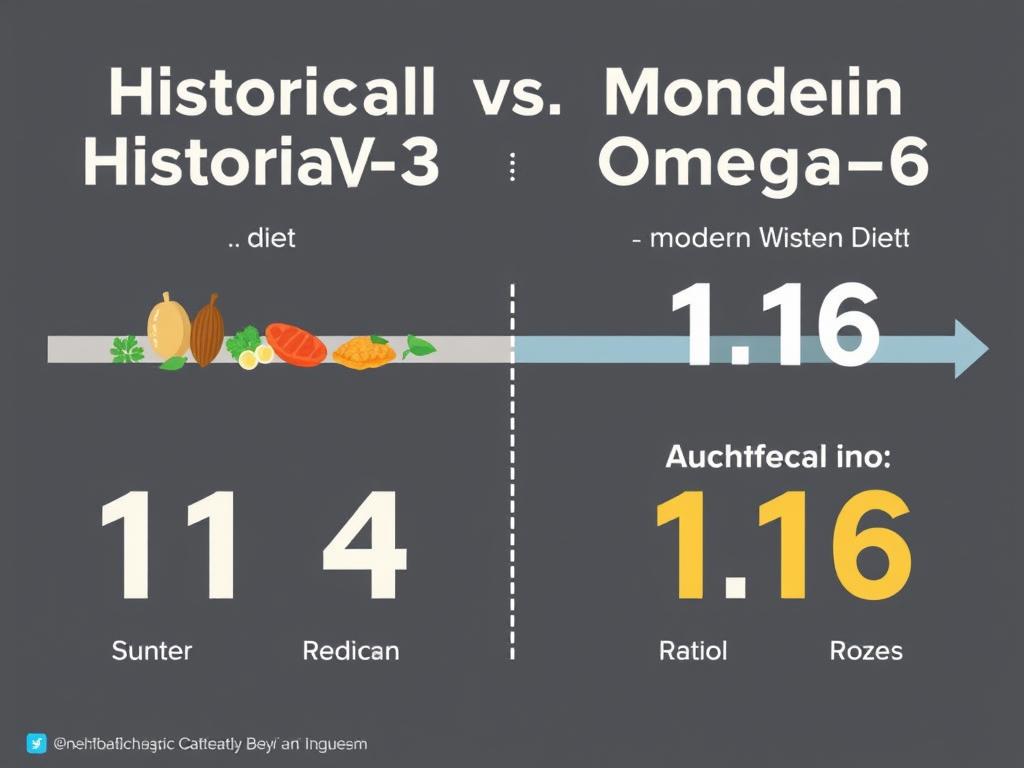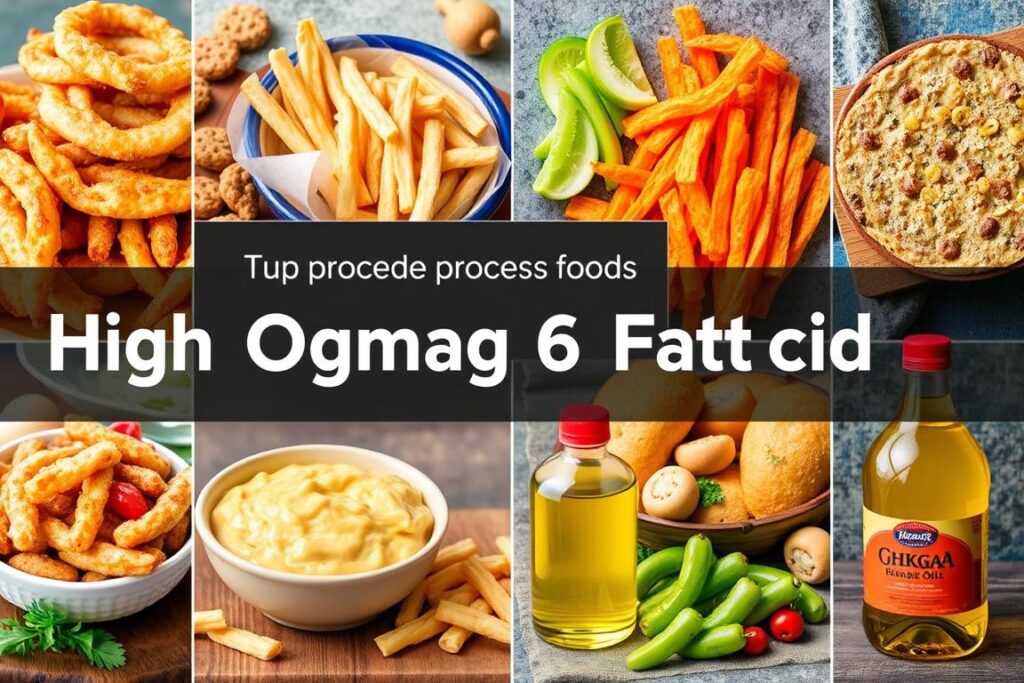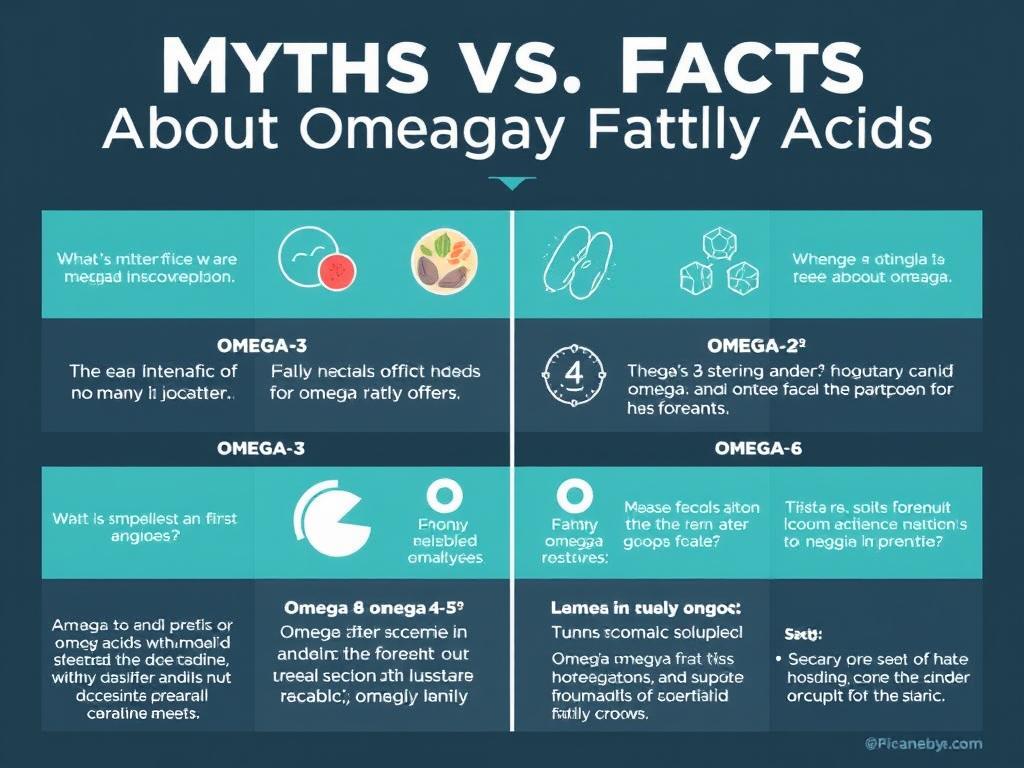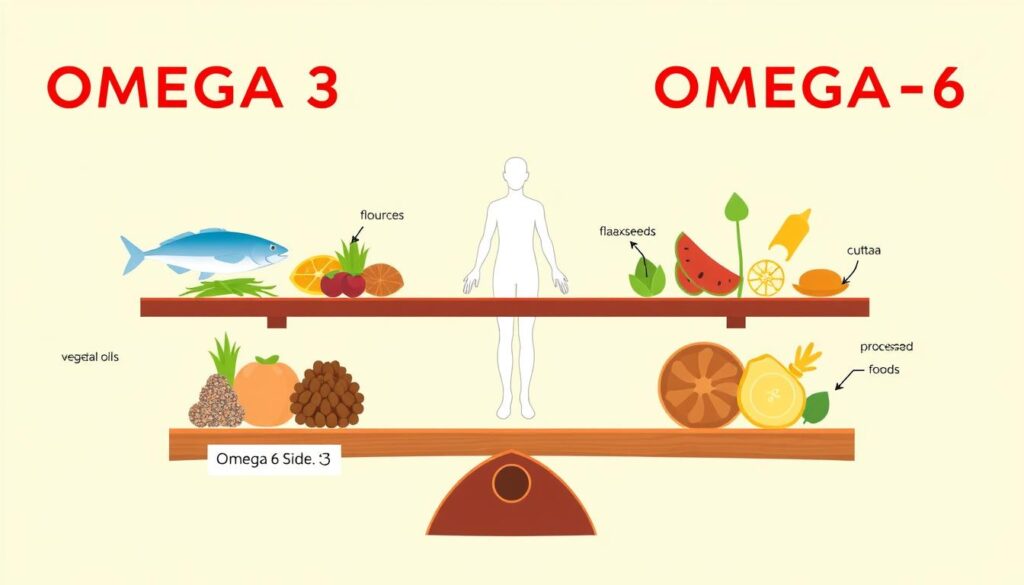Understanding Omega-3 and Omega-6 Fatty Acids
Molecular structures and common sources of omega-3 and omega-6 fatty acids
Omega-3 and omega-6 fatty acids are polyunsaturated fats that your body cannot produce on its own. This makes them “essential” fatty acids that must come from your diet. Despite their similar names, these fats have distinctly different effects on your body.
Omega-3 Fatty Acids: The Anti-Inflammatory Allies
Omega-3 fatty acids come in three main forms:
- EPA (Eicosapentaenoic acid): Primarily found in fatty fish, EPA helps reduce inflammation and may improve symptoms of depression.
- DHA (Docosahexaenoic acid): Also found in fatty fish, DHA is crucial for brain development and function, making up about 8% of brain weight.
- ALA (Alpha-linolenic acid): Found in plant sources like flaxseeds and walnuts, ALA can be converted to EPA and DHA in the body, though this conversion is inefficient.
Omega-3 fatty acids are known for their anti-inflammatory properties. They help promote vasodilation (widening of blood vessels), prevent excessive blood clotting, and support brain health.
Omega-6 Fatty Acids: The Double-Edged Sword
The most common omega-6 fatty acid is linoleic acid, which is abundant in vegetable oils, nuts, and seeds. Your body can convert linoleic acid to arachidonic acid (AA), which produces eicosanoids that are generally pro-inflammatory.
While inflammation is essential for immune function and healing, excessive inflammation can contribute to chronic diseases. Omega-6 fatty acids are not inherently “bad” – they’re necessary for energy, brain function, and growth. The problem arises when we consume them in disproportionately high amounts compared to omega-3s.
The Ideal Omega-3 vs Omega-6 Ratio

Historical vs. modern dietary omega-3 to omega-6 ratios
Anthropological evidence suggests that humans evolved on a diet with an omega-6 to omega-3 ratio of approximately 1:1. Hunter-gatherer populations consumed these fats at ratios ranging from 4:1 to 1:4, depending on their geographic location and food sources.
In stark contrast, the modern Western diet has a ratio of about 16:1 or even higher. This dramatic shift has occurred primarily in the last century with the introduction of processed vegetable oils high in omega-6 fatty acids.
“A healthy ratio of omega-6 to omega-3 fatty acids appears to be between 1:1 and 4:1, but studies suggest that people who follow a typical Western diet may consume a ratio of between 15:1 and almost 17:1.”
Health experts and researchers generally recommend aiming for a ratio between 1:1 and 4:1 for optimal health. This doesn’t mean eliminating omega-6 fatty acids, but rather increasing omega-3 intake while moderating omega-6 consumption.
Why the Omega-3 vs Omega-6 Ratio Matters

Effects of imbalanced omega ratios on inflammation and cellular function
The imbalance between omega-3 and omega-6 fatty acids in the modern diet has significant health implications. Here’s why this matters:
Chronic Inflammation
A high omega-6 to omega-3 ratio promotes a pro-inflammatory state in the body. While acute inflammation is a necessary immune response, chronic inflammation is linked to numerous diseases including heart disease, diabetes, arthritis, and certain cancers.
A 2023 study published in the Journal of Nutritional Biochemistry found that balancing the omega-6:omega-3 ratio significantly reduced inflammatory markers in adults with metabolic syndrome.
Cardiovascular Health
Omega-3 fatty acids help improve heart health by managing cholesterol, triglyceride, and blood pressure levels. An imbalanced ratio may contribute to atherosclerosis and heart failure.
Research published in the American Journal of Clinical Nutrition (2021) demonstrated that individuals with higher omega-3 levels had a 13% lower risk of cardiovascular events compared to those with lower levels.
Brain Function and Mental Health
DHA, an omega-3 fatty acid, makes up a significant portion of brain tissue. Proper omega-3 levels support cognitive function and may help prevent neurodegenerative diseases.
Studies have linked omega-3 supplementation to improvements in depression, anxiety, and other mental health conditions. A balanced omega ratio appears to support optimal brain function throughout life.
Autoimmune Conditions
The pro-inflammatory environment created by a high omega-6:omega-3 ratio may contribute to the development or worsening of autoimmune conditions like rheumatoid arthritis, lupus, and multiple sclerosis.
How the Modern Diet Skews the Ratio

Common processed foods high in omega-6 fatty acids
Several factors in the modern food system have contributed to the dramatic shift in our omega-3:omega-6 ratio:
The Rise of Seed and Vegetable Oils
The technology to process seed oils didn’t exist until about 100 years ago. Today, oils like soybean, corn, and sunflower oil are ubiquitous in processed foods. These oils can contain up to 50 grams of omega-6 fatty acids per 100 grams.
Soybean oil alone now accounts for approximately 7% of total calories in the American diet, making it the largest source of omega-6 fatty acids in the U.S.
Industrial Farming Practices
Even animal products have changed. Conventionally raised livestock are typically fed grain-based diets high in omega-6. This significantly reduces the omega-3 content in meat, eggs, and dairy compared to animals raised on their natural diets.
For example, grass-fed beef typically has a much more favorable omega-3:omega-6 ratio than grain-fed beef.
Ultra-Processed Foods
The prevalence of ultra-processed foods in the modern diet further skews the ratio. These products often contain multiple sources of omega-6 fatty acids while being devoid of omega-3s.
Did you know? The amount of omega-6 fatty acids found in body fat stores has increased by more than 200% in the past 50 years alone.
Practical Steps to Balance Your Omega-3 vs Omega-6 Ratio

A balanced meal rich in omega-3 fatty acids
Balancing your omega-3 to omega-6 ratio doesn’t require radical diet changes. Here are practical steps you can take:
1. Reduce Omega-6 Intake
- Limit vegetable oils high in omega-6, such as soybean, corn, cottonseed, and sunflower oils.
- Choose healthier cooking oils like olive oil, coconut oil, or avocado oil, which have lower omega-6 content.
- Minimize processed foods, which often contain multiple sources of omega-6 fatty acids.
- Read labels to identify hidden sources of vegetable oils in packaged foods.
2. Increase Omega-3 Intake
- Eat fatty fish at least twice per week (salmon, mackerel, sardines, anchovies).
- Choose grass-fed meat and pasture-raised eggs when possible.
- Add plant sources of omega-3 like flaxseeds, chia seeds, hemp seeds, and walnuts to your diet.
- Consider algae-based omega-3 supplements if you follow a vegetarian or vegan diet.
| Food | Omega-3 Content (per serving) | Best Uses |
| Salmon (4 oz) | 4.0g EPA and DHA | Grilled, baked, or in salads |
| Mackerel (4 oz) | 3.0g EPA and DHA | Grilled or smoked |
| Sardines (3.75 oz can) | 2.2g EPA and DHA | On toast, in pasta, or salads |
| Flaxseeds (1 tbsp) | 2.3g ALA | Smoothies, oatmeal, baking |
| Chia seeds (1 tbsp) | 1.8g ALA | Puddings, smoothies, baking |
| Walnuts (1/4 cup) | 2.5g ALA | Snacking, salads, baking |
3. Consider Supplementation
If you struggle to get enough omega-3 from your diet, high-quality supplements can help. Look for products that:
- Contain both EPA and DHA
- Are third-party tested for purity
- Use sustainable sourcing practices
- Include an antioxidant like vitamin E to prevent oxidation
Balance Your Omega Ratio Today
Looking for a high-quality omega-3 supplement? Our third-party tested fish oil provides the optimal balance of EPA and DHA to help improve your omega-3:omega-6 ratio.
Debunking Common Myths About Omega Fatty Acids

Common myths and facts about omega fatty acids
Myth #1: “All omega-6 fatty acids are bad for you”
Fact: Omega-6 fatty acids are essential nutrients that your body needs. The problem isn’t omega-6 itself, but rather the excessive amounts in the modern diet relative to omega-3.
A 2022 study in the Journal of Lipid Research found that certain omega-6 fatty acids, particularly gamma-linolenic acid (GLA), may actually have anti-inflammatory effects when consumed in appropriate amounts.
Myth #2: “Plant-based omega-3s are just as effective as those from fish”
Fact: Plant sources provide ALA, which the body must convert to EPA and DHA. This conversion is inefficient (less than 10% for EPA and less than 5% for DHA).
While plant sources of omega-3 are beneficial, they generally don’t provide the same direct benefits as marine sources of EPA and DHA. Vegans and vegetarians may want to consider algae-based EPA and DHA supplements.
Myth #3: “Taking mega-doses of omega-3 is better”
Fact: More isn’t always better. Extremely high doses of omega-3 (above 3g per day) may increase bleeding risk in some individuals, especially those on blood-thinning medications.
Focus on achieving a balanced ratio rather than extremely high intake of either fatty acid. For most people, 250-500mg of combined EPA and DHA daily is sufficient for general health.
Frequently Asked Questions About Omega-3 vs Omega-6 Ratio

Many people have questions about optimizing their omega fatty acid intake
Can supplements fix an imbalanced omega-3 to omega-6 ratio?
Supplements can help improve your ratio, but they work best as part of a comprehensive approach. While omega-3 supplements can increase your omega-3 levels, simultaneously reducing omega-6 intake through dietary changes will have a more significant impact on your overall ratio.
If you choose to supplement, look for high-quality fish oil or algae-based products that provide at least 500mg of combined EPA and DHA per daily serving.
Want to learn which omega-3 supplement might be right for you? Download our free guide to choosing quality supplements.
How long does it take to restore balance to my omega-3 vs omega-6 ratio?
Improving your omega ratio is a gradual process. The omega-6 fatty acids stored in your body’s fat tissues can take time to diminish. Most people begin to see changes in their blood markers within 3-4 months of consistent dietary changes and/or supplementation.
A 2020 study published in the American Journal of Clinical Nutrition found that participants who increased their omega-3 intake while reducing omega-6 consumption showed significant improvements in their fatty acid profiles after 12 weeks.
Remember that this is a long-term lifestyle change rather than a quick fix. Consistency is key to seeing lasting benefits.
What’s the best omega-3 to omega-6 ratio for athletes?
Athletes may benefit from a slightly different approach to omega fatty acids. While the general recommendation of a 1:1 to 4:1 ratio still applies, athletes often need more total calories and fats, including some omega-6 fatty acids for energy.
Recent research suggests that athletes should focus on getting adequate omega-3 (at least 2g daily for those in heavy training) while not being overly restrictive of omega-6 from whole food sources like nuts and seeds.
A 2021 study in the Journal of the International Society of Sports Nutrition found that omega-3 supplementation combined with resistance training improved muscle recovery and reduced inflammation in athletes.
Understanding Omega Balance: The Seesaw Analogy

The omega fatty acid seesaw: balance is key
Think of the omega-3 to omega-6 ratio as a seesaw in your body. When balanced, this seesaw allows for optimal health and functioning. But in the modern diet, the seesaw is heavily weighted toward the omega-6 side.
Imagine omega-3 and omega-6 fatty acids as rival siblings in your body. Both are important family members with essential roles, but when one sibling (omega-6) becomes too dominant, they start causing problems in the household. The other sibling (omega-3) helps keep the peace, but can only do so when present in sufficient numbers.
Just as you wouldn’t want one child to completely dominate family decisions, you don’t want omega-6 fatty acids to overwhelm your body’s systems. Balance is key – both siblings need to have appropriate influence for the family (your body) to function harmoniously.
When you consume more omega-3 rich foods and fewer processed omega-6 sources, you’re essentially giving the quieter sibling a megaphone while asking the louder one to speak more softly. This restored balance allows your body’s inflammatory responses, cardiovascular system, and brain function to operate as nature intended.
Conclusion: Finding Your Optimal Omega-3 vs Omega-6 Balance

Creating balanced meals is key to optimizing your omega-3 to omega-6 ratio
The omega-3 vs omega-6 ratio is a critical yet often overlooked aspect of nutritional health. While both fatty acids are essential, the dramatic shift in our dietary patterns has created an imbalance that may contribute to chronic inflammation and various health conditions.
By making conscious choices to reduce processed omega-6 sources while increasing omega-3-rich foods, you can gradually restore a healthier balance. Remember that this isn’t about eliminating omega-6 entirely, but rather achieving the ratio that humans evolved to thrive on.
Small, consistent changes can make a significant difference over time. Whether it’s swapping vegetable oils for olive oil, enjoying fatty fish twice a week, or choosing grass-fed animal products when possible, each step brings you closer to optimal omega balance.
Take Control of Your Omega Balance
Ready to optimize your omega-3 to omega-6 ratio? Download our free 7-day meal plan featuring delicious recipes designed to improve your fatty acid balance.
Remember that balancing your omega fatty acids is just one aspect of a healthy lifestyle. Combined with regular physical activity, adequate sleep, and stress management, optimizing your omega-3 vs omega-6 ratio can help you build a solid foundation for long-term health and wellbeing.


[…] The secret to creamy desserts lies in nature’s butter. Traditional versions rely on sugar-laden foundations, but our method uses ripe avocados for unmatched smoothness. This swap cuts refined sugars while boosting nutrient density – a win for taste and health. […]